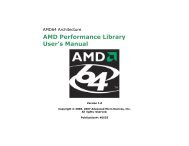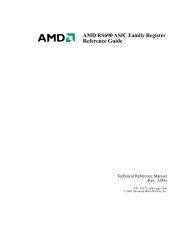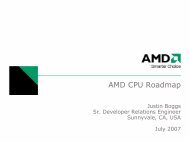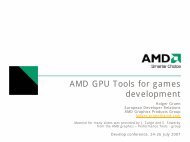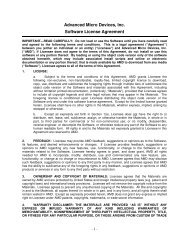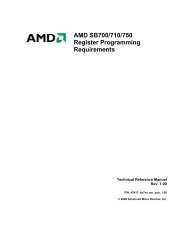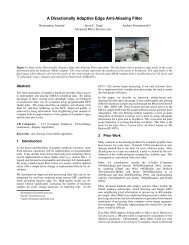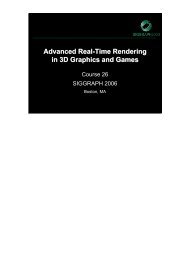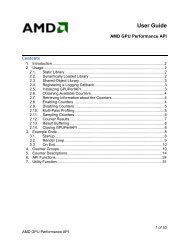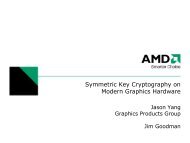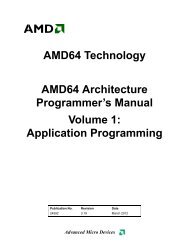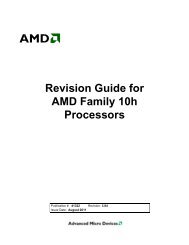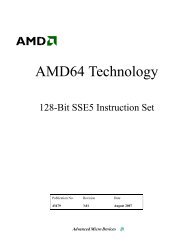The Parthenon Demo - AMD Developer Central
The Parthenon Demo - AMD Developer Central
The Parthenon Demo - AMD Developer Central
You also want an ePaper? Increase the reach of your titles
YUMPU automatically turns print PDFs into web optimized ePapers that Google loves.
<strong>The</strong> <strong>Parthenon</strong> <strong>Demo</strong><br />
Preprocessing and Real-Time Real Time Rendering<br />
Techniques for Large Datasets<br />
Pedro Sander<br />
ATI Research
Introduction<br />
• At Siggraph 2004 Debevec et al presented “<strong>The</strong> <strong>Parthenon</strong>”.<br />
– Structures laser-scanned and photographed<br />
– Captured HDR Lighting<br />
• Our goal was to make a real-time version of this demo using<br />
these datasets.
<strong>The</strong> Challenge<br />
• <strong>The</strong>se sizes of the datasets are humongous!<br />
– 15 million triangles of geometry.<br />
• Simplified from original raw 90 million triangle model.<br />
– 2.1GB of HDR sky imagery.<br />
– 300MB (@350 512x512 textures) of texture data.<br />
• This talk focuses on techniques for compressing,<br />
managing, and rendering these datasets in real-time on<br />
our next generation graphics cards.
Overview<br />
• Progressive Buffers<br />
• Video skybox<br />
• Lighting and rendering
Overview<br />
• Progressive Buffers<br />
• Video skybox<br />
• Lighting and rendering
Overview<br />
• A data structure and system for rendering of<br />
a large polygonal model:<br />
– Out-of-core<br />
– Texture/normal-mapping support<br />
– Smooth transitions between levels of detail<br />
(no popping)
Progressive Buffer Example
Progressive Buffer Example<br />
• Example: Five levels of detail color coded from<br />
Red (highest res) to green (lowest res)
Talk outline<br />
• Previous work<br />
• <strong>The</strong> progressive buffer<br />
– Geometry LOD<br />
– Texture LOD<br />
– Coarse buffer hierarchy<br />
• Automatic LOD control<br />
• Memory management<br />
• Results<br />
• Future directions
Previous work<br />
• View-dependent rendering (early works)<br />
• [e.g., Xia and Varshney 1996, Hoppe 1997, Luebke<br />
and Ericson 1997, …]<br />
– Mostly per triangle operations<br />
• Out-of-core view-dependent rendering<br />
[e.g., El-Sana and Chiang 2000, Vadrahan and<br />
Manocha 2002, Lindstrom 2003, Cignoni et al 2004,<br />
Yoon et al 2004, …]<br />
– Multiple static buffers<br />
– More efficient on current GPUs
Previous work<br />
• Geomorphing static buffers<br />
[Gain 03]<br />
• Per-vertex geomorphing<br />
[Grabner 01]<br />
• Our method:<br />
– Geomorphs on GPU<br />
– Texture mapping<br />
– Hierarchy of clusters to reduce draw calls<br />
• More similar to independent work of Borgeat 05
Continuous LOD control<br />
• Texture-mapping<br />
Allows for lower geometric level of detail without loss<br />
in quality (e.g., flat regions can be textured).<br />
• Geomorphing<br />
A lower number of rendered triangles causes<br />
undesired popping when changing level of detail.<br />
Geomorphing provides a smoother transition.<br />
• Summary:<br />
– Complex models<br />
– Wide range of graphics hardware<br />
– No need for tiny pixel-sized triangles
<strong>The</strong> progressive buffer (PB)<br />
Preprocess (mostly based on previous methods):<br />
• Split model into clusters<br />
• Parametrize clusters and sample textures<br />
• Create multiple (e.g., five) static vertex/index buffers for<br />
different LODs, each having ¼ of the vertices of its parent<br />
– We achieved this by simplifying each chart at time from one LOD<br />
down to the next, also simplifying the boundary vertices to its<br />
neighbor<br />
– Simplify respecting boundary constraints and preventing texture<br />
flips<br />
[Cohen 98, Sander 01]<br />
• Perform vertex cache optimization for each of these buffers<br />
[DX9; Hoppe 99]
Texture parametrization<br />
• Goal: Penalizes undersampling<br />
– L 2 geometric stretch of Sander et al. [2001]<br />
– Hierarchical algorithm to generate texture<br />
coordinates
Straight texture boundaries<br />
fine mesh<br />
coarse mesh<br />
texture map
Straight boundary distortion
Texture packing<br />
• Tetris packing [Levy 02]<br />
– Goal: minimize wasted space (red)<br />
– Place a chart at a time<br />
(from largest to smallest)<br />
– Pick best position and rotation<br />
(minimize wasted space)<br />
– Repeat above for multiple<br />
square dimensions<br />
• pick best
<strong>The</strong> progressive buffer (PB)<br />
Static buffers:<br />
• Each static buffer will contain an<br />
index buffer and two vertex<br />
buffers:<br />
– Fine vertex buffer<br />
Representing the vertices in the current<br />
LOD<br />
– Coarse vertex buffer<br />
Vertex-aligned with the fine buffer such that<br />
each vertex corresponds to the “parent”<br />
vertex of the fine buffer in the next coarser<br />
LOD<br />
(Note: requires vertex duplication)<br />
fine coarse<br />
9 6<br />
8 4<br />
7 1<br />
6 6<br />
5 5<br />
4 4<br />
3 3<br />
2 2<br />
1 1<br />
PB i
LOD=4 LOD=3 …<br />
<strong>The</strong> progressive buffer (PB)<br />
v s<br />
v s<br />
v u<br />
v t<br />
v u<br />
v u<br />
v v<br />
v u<br />
Vertex parents for LOD=4: v s ,v t ,v v v u<br />
…<br />
…
<strong>The</strong> progressive buffer (PB)<br />
Runtime:<br />
• A static buffer is streamed to<br />
vertex shader<br />
(LOD determined based on cluster’s center<br />
distance to camera)<br />
• Vertex shader smoothly blends<br />
position, normal and UVs.<br />
(blending weight based on vertex distance to<br />
camera)<br />
fine coarse<br />
9 6<br />
8 4<br />
7 1<br />
6 6<br />
5 5<br />
4 4<br />
3 3<br />
2 2<br />
1 1<br />
PB i
Buffer geomorphing<br />
• Decrease level of detail:<br />
– Geomorph<br />
PB i orange yellow<br />
– Switch buffer<br />
PB i PB i-1<br />
– Geomorph<br />
PB i-1 yellow green<br />
– …<br />
fine coarse<br />
• Increase level of detail by reversing the order of<br />
operations.<br />
9<br />
8<br />
7<br />
6<br />
5<br />
4<br />
3<br />
2<br />
1<br />
PB i<br />
6<br />
4<br />
1<br />
6<br />
5<br />
4<br />
3<br />
2<br />
1<br />
fine coarse<br />
6<br />
5<br />
4<br />
3<br />
2<br />
1<br />
PB i-1<br />
3<br />
2<br />
2<br />
3<br />
2<br />
1
How it works<br />
LOD<br />
vertex LOD<br />
s<br />
PB n PB n-1 PB n-2<br />
r<br />
distance to camera<br />
geomorph geomorph geomorph<br />
e<br />
k<br />
r e r e r<br />
2k<br />
4k
LOD bands and weights<br />
vertex LOD<br />
s<br />
PB n PB n-1 PB n-2<br />
distance to camera<br />
geomorph geomorph geomorph<br />
e<br />
r e r e r<br />
k 2k 4k<br />
d<br />
d s d e
Texture LOD<br />
• Analogous to vertex LOD<br />
• Each LOD also has texture<br />
• Each coarser LOD has ¼ of the # of vertices and ¼ of the #<br />
of texels of the previous LOD<br />
• Essentially, we drop the highest mip level when coarsening,<br />
and add a mip level when refining<br />
• Textures are blended just like vertices:<br />
– Vertex geomorph weight passed down to pixel shader<br />
– Pixel shader performs two fetches (one per LOD)<br />
– Pixel shader blends resulting colors according to the interpolated<br />
weight
Coarse buffer hierarchy (CBH)<br />
• Store coarse LOD of all clusters in a single<br />
vertex/index/texture buffer in video memory<br />
• Group draw calls when adjacent clusters are<br />
far from camera<br />
PB 0<br />
A<br />
B<br />
C<br />
D<br />
E<br />
F<br />
G<br />
H<br />
AB<br />
CD<br />
EF<br />
GH<br />
AD<br />
EH<br />
AH<br />
AH<br />
AD EH<br />
AB CD EF GH<br />
A B C D E F G H
Coarse buffer hierarchy (CBH)<br />
• Binary tree constructed using a bottom-up<br />
greedy merge algorithm<br />
• Priority metric is the radius of bounding<br />
sphere of potential merged cluster<br />
PB 0<br />
A<br />
B<br />
C<br />
D<br />
E<br />
F<br />
G<br />
H<br />
AB<br />
CD<br />
EF<br />
GH<br />
AD<br />
EH<br />
AH<br />
AH<br />
AD EH<br />
AB CD EF GH<br />
A B C D E F G H
CBH textures<br />
• Textures of voxels at coarsest LOD are grouped:<br />
• Always stored in video memory<br />
• Texture coordinates in the CBH buffer adjusted.<br />
• No visible popping when switching from coarse<br />
static buffer to CBH buffer
Limitations of data structure<br />
• Vertex buffer size is doubled<br />
(but only small subset of data resides in video memory)<br />
• Clusters should be about the same size<br />
(a large cluster would limit minimum LOD band size)<br />
• Larger number of draw calls than purely<br />
hierarchical algorithms<br />
(cannot switch textures within same draw call;<br />
coarse level hierarchy partly addresses this)<br />
• Texture stretching due to straight boundaries
Automatic LOD control<br />
• Bounds:<br />
– System memory<br />
– Video memory<br />
– Framerate (less stable)<br />
– Maximum band size<br />
• Values of k and s slowly adjusted accordingly to<br />
remain within the above bounds<br />
vertex LOD<br />
s<br />
geomorph geomorph geomorph<br />
e<br />
r e r e r<br />
k 2k 4k
Memory management<br />
• Separate thread loads data, and based on<br />
distance to viewer sets priorities as follows:<br />
Priority<br />
3 (active)<br />
2 (almost active)<br />
1 (needed soon)<br />
0 (not needed)<br />
System memory<br />
Yes<br />
Yes<br />
Yes<br />
No<br />
Video memory*<br />
Yes<br />
Yes<br />
No<br />
No<br />
Sample bounds<br />
100MB<br />
20MB<br />
50MB<br />
Full dataset<br />
*Priority (with LRU as tie-breaker) used for determining what is loaded on video memory
Memory management<br />
• We compute continuous LOD of each buffer.<br />
• Taking the integer part, we get the static buffer,<br />
and assign it priority 3:<br />
• If the continuous LOD is within a specified<br />
threshold of another static buffer’s LOD, we set<br />
that buffer’s priority accordingly:<br />
Threshold<br />
e video<br />
e system<br />
Priority<br />
2<br />
1<br />
Target<br />
Video memory<br />
System memory<br />
Example<br />
0.75<br />
1.00
Prefetching results<br />
• By prefetching and keeping approximately 20% of<br />
additional data than that being rendered, we<br />
ensure we have the appropriate cluster LODs<br />
required for rendering<br />
• Without prefetching, several buffers may become<br />
Unavailable clusters<br />
unavailable: 16<br />
14<br />
12<br />
10<br />
8<br />
6<br />
4<br />
2<br />
0<br />
• May vary dramatically based on hard drive seek<br />
times, background tasks, other CPU usage.
Memory (MB)<br />
0<br />
10<br />
20<br />
30<br />
40<br />
50<br />
60<br />
70<br />
80<br />
90<br />
System<br />
Video<br />
Rendered<br />
Statistics<br />
Statistics<br />
FPS<br />
0<br />
20<br />
40<br />
60<br />
80<br />
100<br />
120<br />
140<br />
Fixed LOD<br />
Variable LOD<br />
FPS<br />
0<br />
20<br />
40<br />
60<br />
80<br />
100<br />
120<br />
140<br />
Memory (MB)<br />
0<br />
20<br />
40<br />
60<br />
80<br />
100<br />
120<br />
140<br />
160<br />
180<br />
System<br />
Video<br />
Rendered
Shadow map example<br />
• Uses CBH to do one draw call to render shadow<br />
map
Instancing example<br />
1600 dragons, 240M polygons
Instancing example
Possible improvements<br />
Take advantage of new hardware features:<br />
• With performant vertex fetch, can consider fetching<br />
all coarse vertex data (20 bytes) from textures to<br />
avoid buffer duplication<br />
• Instead of blending between two textures, one of<br />
which simply contains an extra mip level, we can:<br />
– query mip level for highest LOD<br />
– adjust it based on blending weights with lowest LOD<br />
– perform a single fetch
Future work<br />
• Hierarchical CBH textures<br />
(requires multiple texture coordinates)<br />
• Animated geometry<br />
(need to preprocess conservative bounding<br />
spheres)<br />
• Tiled geometry<br />
(need to simplify respecting boundary constraints)
Summary<br />
• Presented new LOD algorithm for rendering<br />
large datasets<br />
• Features include:<br />
– Out-of-core rendering with prefetching<br />
– Texture-mapping<br />
– Geomorphing<br />
– Uses “GPU-friendly” irregular meshes<br />
– Only requires based shader programmability
Up Next: Video Skybox<br />
• Progressive Buffers<br />
• Video skybox<br />
• Lighting and Rendering
Input Skybox Imagery<br />
8am 10am noon<br />
2pm 4pm sunset<br />
• Input: 2.1GB compressed HDR imagery, captured at one<br />
minute intervals over the course of the day.<br />
– (670 frames of data: each frame 1024x1024 anglemap)<br />
• Goal: we would like to compress this data in a compact<br />
and performant manner for playback and HW rendering.
Preprocessing: Resampling<br />
• HDR skybox re-sampled from angular mapping<br />
to a paraboloid environment map.<br />
– Simplifies per-pixel math for rendering the sky box only<br />
tex2dproj is required.
Preprocessing: SH Estimation<br />
• HDR lighting information is derived and recorded for<br />
each frame using 3 rd order spherical harmonics (SH).<br />
• This lighting information is used to provide diffuse<br />
lighting information to render the scene.
Preprocessing: Range Reduction<br />
• Each frame of video is divided through by the SH<br />
representation in order to reduce the range of<br />
each frame to a 24-bit RGB image.
Encoding the Video Sequence<br />
• <strong>The</strong> reduced range video<br />
frames can be compressed<br />
using a standard video<br />
codec.<br />
– We found that DivX and XVid<br />
worked well.<br />
– 1024x1024, 670 frame<br />
sequence reduced from 2.1GB<br />
to 38.1MB<br />
– 72k for SH coefficients for all<br />
frames. (27 floats per frame)<br />
– 1MB optic flow data……
Preprocessing: Optic Flow<br />
• Making a little video go a long way<br />
– 670 frames at 30fps is only @ 23 seconds of video.<br />
– Playback at a lower frame rate is choppy even with lerp between<br />
frames.<br />
• Estimate optic flow between frames to estimate cloud<br />
motion.<br />
• At runtime optic flow is used to warp one frame into the<br />
next.<br />
– Gives additional in-between frames, can use lower FPS video.<br />
• Optic flow is stored as a 16x16x1024 R16G16 volume<br />
texture<br />
– Texture filtering for smooth interpolation between flow fields.
Video Playback<br />
• At runtime video is decoded and used as a texture.<br />
– Video is decompressed on the fly in its own thread.<br />
• Optic flow based warping between frames in pixel shader.<br />
– Current frame is warped toward next frame.<br />
– Next frame is inverse warped back towards current frame.<br />
– Results are lerped together. (similar to morphing)<br />
– Flow is selectively applied (in area around sun, the flow is attenuated)<br />
• Summary<br />
– Fast (two lookups, and blend)<br />
– Compact (DivX compression)
Up Next: Lighting and Rendering<br />
• Progressive Buffers<br />
• Video skybox<br />
• Lighting and Rendering
Ambient Lighting from Sky<br />
sunrise late morning afternoon<br />
sunset<br />
• Per-vertex bent normal used to lookup into SH representation.<br />
– Cartesian SH evaluation used, 12 instructions for 3 rd order.<br />
• Ambient occlusion texture (half resolution) used to attenuate<br />
ambient lighting.
Direct Lighting from the Sun<br />
sunrise late morning afternoon<br />
sunset<br />
• Per frame sun color, intensity and position extracted<br />
from skybox.<br />
• Bump mapping was only needed as detail texture.
Shadow mapping<br />
morning mid-day late afternoon<br />
• Uses CBH for lowest level of detail to render shadow map using a<br />
single draw call.<br />
• Multi-tap PCF w/ random rotation<br />
• Selective post process blurring of shadow edges<br />
– Computation culling with early-z
Shadow mapping PCF<br />
1 tap 4 tap PCF
Shadow mapping PCF<br />
16 tap PCF<br />
4 tap PCF
Reusing shadow map tests<br />
• Store shadow in alpha<br />
• Read previously combined results from alpha<br />
(using projection matrix of previous frame)<br />
• Recursively combine new and old results<br />
• Store new shadow opacity value on alpha<br />
• Display
Shadow mapping comparison<br />
16 tap PCF 4 tap amortized
Shadow mapping comparison<br />
4 tap amortized<br />
4 tap PCF
Amortized computation<br />
• For additional details on this amortized<br />
computation, see:<br />
• Sketch: Cache Flow session<br />
<strong>The</strong> Real-Time Reprojection Cache<br />
Thursday, 3 August<br />
3:45-5:00 (last talk)
Haze & Lighting for Far Geometry<br />
• Haze in distance also uses color from SH representation of sky.<br />
– Better match with sky color than single color haze.<br />
– Terrain blended using distance, sky blended using horizon.<br />
• Sky texture used to project cloud shadows onto far geometry.
Fading in the sculptures<br />
Fade In<br />
Fade Out<br />
• Cross fade between statues in museum and on pediment.<br />
– Statue geometry is rendered only once with interpolation between the<br />
two different lighting conditions inside the shader.
Occlusion Query Geometry Culling<br />
All probing quads Active probing quads for current frame<br />
• Each cluster drawn is occlusion query tested to see how many<br />
pixels get drawn for the current frame.<br />
– If any pixels get drawn, the voxel is flagged to be drawn next frame.<br />
– If no pixels get drawn, the next frame an inexpensive ‘probing’ quad is<br />
rendered with color and Z writes disabled instead of the voxel.
Overview<br />
• Progressive Buffers<br />
• Video skybox<br />
• Lighting and rendering
Acknowledgements<br />
• John Isidoro, Jason Mitchell, and Josh Barczak for<br />
participating in the development and implementation of<br />
the parthenon demo.<br />
• Eli Turner for his work on the datasets and all the<br />
additional original artwork that went into this demo.<br />
• Paul Debevec and Andrew Jones for providing the<br />
<strong>Parthenon</strong> dataset and HDR skybox imagery<br />
• For more information on Progressive Buffers see:<br />
[Sander05] P. V. Sander and J. L. Mitchell, “Progressive Buffers:<br />
View Dependent Geometry and Texture LOD”, Symposium on<br />
Geometry Processing 2005
Thank you!<br />
• Thank you for attending!



